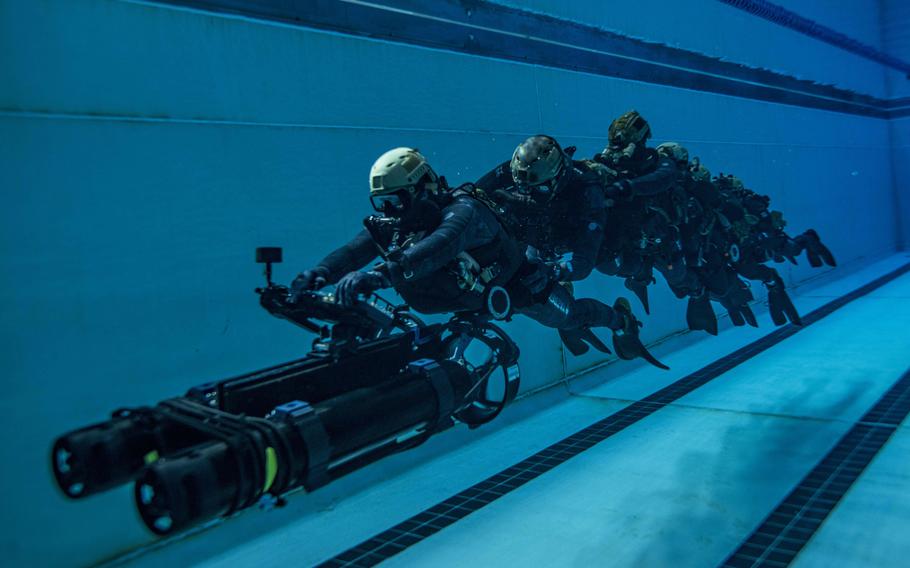
SEAL team members use a propulsion vehicle during an exercise in Virginia Beach, Va., July 1, 2024. (Trey Hutcheson/U.S. Navy)
A former Australian Special Air Service officer now serving in his country’s parliament wants U.S. Navy SEALs to train local troops to dive from nuclear-powered submarines Down Under.
A detachment of SEALs should join Submarine Rotational Force-West, scheduled to begin operations at HMAS Sterling, near Perth, in 2027, Andrew Hastie, the Liberal Party shadow defense minister, told Stars and Stripes by phone Thursday.
The former SAS troop commander and Afghanistan war veteran trained to dive from Australian conventional submarines. He pitched his proposal in an opinion piece published Wednesday in The Australian newspaper.
Hastie, a House of Representative member elected from a district near HMAS Stirling, recently toured the USS Hawaii at the naval base. The Virginia-class fast-attack submarine arrived Aug. 26 for several weeks of maintenance by American and Australian technicians.
The visit is designed to build local skills ahead of the deployment in 2027 of one British and four U.S. nuclear-powered boats to the naval base under the 2021 AUKUS defense pact, named for members Australia, United Kingdom and the United States.
As part of the pact the U.S. has pledged to arm Australia with at least three Virginia-class submarines starting in 2032, before Australia can build as many as five new nuclear-powered AUKUS vessels.
Hastie checked out bunks on the Hawaii that can house a platoon of SEALs with space for their weapons and gear. He also saw the lockout chamber that allows divers to emerge from the vessel underwater, he said.
“I have a large and growing navy presence in my district,” Hastie said. “I am expecting to have American kids in our schools.”
The SEALs could train on the same world-class facilities as Australia’s Special Air Service Regiment at Campbell Barracks, Perth, he said.
The proposal has the backing of former SAS Regiment commander Duncan Lewis who was quoted in The Australian on Wednesday as saying: “I strongly support what Andrew’s saying.”
Nuclear-powered submarines should come to Australia with complete capabilities, Lewis said.
“And one of those capabilities is the deployment of special forces from the submarines,” he said. “In the U.S. context, that is done by U.S. Navy SEALs.”
The Naval Special Warfare Center in San Diego referred questions about a potential Navy SEAL mission in Australia to the Naval Special Warfare Command, which did not immediately respond to emailed questions Thursday.
Navy Cmdr. Matthew Comer, a spokesman for U.S. Indo-Pacific command, said by email Thursday that AUKUS focuses only on capabilities development, such as the plan for Australia to acquire nuclear-powered submarines.
Outside AUKUS, the U.S. conducts “high-end defense cooperation with Australia to include special operations,” he said.
The Australian navy has diving specialists, but SAS divers are likely to work from the nuclear-powered submarines for covert patrol insertion and extraction, former Australian assistant defense secretary Ross Babbage wrote in an email to Stars and Stripes Wednesday.
“Training with US Navy SEALs to make the most of the capability provided by Australia’s new nuclear-powered submarines will be a valuable extension of the existing covert capabilities held by the SAS,” he said.
The SAS and its forebearers have experience operating from conventional submarines dating back to World War II, said Carlyle Thayer, an emeritus professor at the University of New South Wales and a lecturer at the Australian Defence Force Academy.
“SAS troopers can be launched and recovered from Australia’s Collins-class (diesel-electric) submarines,” he said, by email Thursday. “However, the Collins-class submarine can only launch while surfaced and its range is limited.”